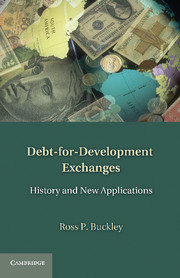Book contents
- Frontmatter
- Contents
- Acknowledgments
- List of Contributors
- Introduction: A Productive Partnership between Civil Society and the Academy
- Part I Types of Exchanges and Their Development over Time
- Part II Exchanges by Donor Countries
- Part III Critiques of Exchanges
- Part IV Innovative Applications of Exchanges
- 15 Farmer-Managed Natural Regeneration: A Land Rehabilitation Technique Well Adapted to Funding by Exchanges
- 16 Restoring Mangroves in the Philippines
- 17 Poverty Reduction through Social Protection: A Potential Form of Debt-for-Development Exchange
- 18 Climate Change Adaptation Exchanges: An Exploration of the Possibilities and Risks
- 19 Climate Change and Food Security: Building Resilience by Means of Climate Field Schools
- 20 Debt-for-Security Exchanges
- 21 Promoting Good Governance through ICT Systems: Improving Transparency and Reducing Corruption
- 22 Using Debt Exchanges to Enhance Public Accountability to Citizens
- Conclusion
- Index
- References
15 - Farmer-Managed Natural Regeneration: A Land Rehabilitation Technique Well Adapted to Funding by Exchanges
Published online by Cambridge University Press: 01 June 2011
- Frontmatter
- Contents
- Acknowledgments
- List of Contributors
- Introduction: A Productive Partnership between Civil Society and the Academy
- Part I Types of Exchanges and Their Development over Time
- Part II Exchanges by Donor Countries
- Part III Critiques of Exchanges
- Part IV Innovative Applications of Exchanges
- 15 Farmer-Managed Natural Regeneration: A Land Rehabilitation Technique Well Adapted to Funding by Exchanges
- 16 Restoring Mangroves in the Philippines
- 17 Poverty Reduction through Social Protection: A Potential Form of Debt-for-Development Exchange
- 18 Climate Change Adaptation Exchanges: An Exploration of the Possibilities and Risks
- 19 Climate Change and Food Security: Building Resilience by Means of Climate Field Schools
- 20 Debt-for-Security Exchanges
- 21 Promoting Good Governance through ICT Systems: Improving Transparency and Reducing Corruption
- 22 Using Debt Exchanges to Enhance Public Accountability to Citizens
- Conclusion
- Index
- References
Summary
INTRODUCTION AND BACKGROUND
Many developing countries' problems are compounded by severe environmental damage, including deforestation, soil erosion and biodiversity loss. Deforestation continues at an alarmingly high rate – about 13 million hectares per year – although the net loss in forest area in the period 2000–2005 is estimated at 7.3 million hectares per year. Seventy-four percent of rangelands and 61% of rain-fed croplands in Africa's drier regions are damaged by moderate to very severe desertification. In some African countries, deforestation rates exceed planting rates by 3,000%. The area of the globe affected by water erosion is roughly 11 million square kilometres and the area affected by wind erosion is around 5.5 million square kilometres. Combined, this equates to an eroded area some 241 times the size of Tasmania. With species extinctions running at about 1,000 times the ‘background’ rate, some biologists contend that we are in the middle of the earth's sixth great extinction.
For many years in Sahelian countries, conventional Western forestry methods were applied to solving desertification and deforestation problems, and exotic tree species were typically favoured over indigenous species. Large and small tree-planting projects were commissioned to curtail the southward movement of the Sahara Desert, but few made any lasting impression. Little thought was given to the appropriateness of this approach. Existing, indigenous vegetation was generally dismissed as ‘useless bush’. In the name of aforestation, many projects even cleared existing woody vegetation in order to make way for exotic species.
- Type
- Chapter
- Information
- Debt-for-Development ExchangesHistory and New Applications, pp. 185 - 198Publisher: Cambridge University PressPrint publication year: 2011

